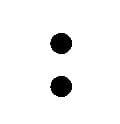 |
| The Colon |
Introductions
Obviously, a colon can be placed after the word that is making the introduction. Some examples are:
- Visit: davidus69.blogspot.com
- The following points arose during the recent fire-drill:
- Rushing out at 90 m.p.h. isn't necessary - normal home-time pace is fine
- Yelling "The end of the world in nigh" isn't totally appropriate
- Hiding in the lavatories isn't a good idea - you'll get caught with your trousers down
- Contact us by:
- Phone: 0800 101010 (won nothing won nothing won nothing - for Man Utd fans)
- Email: brian@dyslexics58585858585anonymous.com
- Beer: The cause of, and solution to, all of life's problems'
No Hypen required - There is no need to place a hyphen after a colon such as:-. It's outdated.
To extend a sentence
A colon can be used to expand on a subject that has been mentioned earlier in the sentence. For example:
- The body was located in two rooms: the lounge and the kitchen.
- The thief's success was due to one fact: he didn't get caught.
Think of a colon as an equal sign.
So using the above example.
- Two rooms = lounge and kitchen
- success = not getting caught
 |
| Bullet Points |
With Bullet points
A colon is often used to introduce bullet points.
Remember, when using bullet points, always treat the punctuation consistently throughout (e.g. capital letters and punctuation at the beginning and end of each bullet). So whatever style you choose, stick to it for the rest of the document.
- Toothpaste helps with:
- Tooth Decay.
- Plaque.
- Profit for the, maufacturing company.
In References
As dividers
Colons are useful to divide up references, titles and times. For example:
- Learn Genesis: Chapter 9: Verse 1 by tomorrow.
- Have you watched "Star Trek IV: The Voage Home"?
- The alarm clock has been set for 06:50.
Before Quotations
A point of note, when introducing a quote of more than six words, use a colom. For anything less, use a comma. Foe example:
- Did Mike Myers really say: "My theory is that all of Scottish cuisine is based on a dare."?
- It was Douglas Adams who said, "Time is an illusion. Lunchtime doubly so".
- Plato said, "Love is a serious mental disease".(only six words so a comma is used)
Thought of the Day
If people evolved from apes, why are there still apes?
Sometimes I respect Your blogs, but then I just do not like You at times. You are mean ;-)
ReplyDeleteMake me apprehensive as I write in english :P